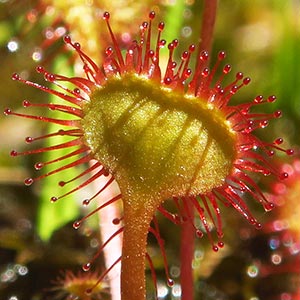Drosera
Drosera rotundifolia
catch-fly, dew-threads, droséra, rossolis, sundew
droséra à feuilles rondes, round-leaf sundew
erect to prostrate;
stipules adnate to petioles their entire length, 4–6 mm, margins fimbriate along distal 1/2;
petiole differentiated from blade, 1.5–5 cm, glandular-pilose;
blade suborbiculate, 0.4–1 cm × 5–12 mm, broader than long, much shorter than petiole.
2–15(–25)-flowered;
scapes 5–35 cm, glabrous.
4–7 mm diam.;
sepals connate basally, oblong, 4–5 × 1.5–2 mm, glabrous;
petals white or pink, spatulate, 5–6 × 3 mm.
obovoid, splitting between placentae.
5 mm.
20–70, minute.
light brown, fusiform, 1–1.5 mm, finely and regularly longitudinally striate, with metallic sheen.
both surfaces in strong sunlight, greener in shade (except D. tracyi, which lacks red pigment even in full sun), unlobed, suborbiculate, orbiculate, spatulate, or obovate, or cuneate to linear pink, or rose to pinkish lavender;
stamens 5, usually connate basally;
gynoecium 3-carpellate;
styles 3, deeply bifid;
stigma capitate.
= 10.
= 20.
Drosera
Drosera rotundifolia
Species ca. 170 (8 in the flora).
Species of Drosera are concentrated in Latin America, South Africa, Madagascar, Australia, and New Zealand.
Droseras, like all carnivorous plants, have leaves that attract, catch, digest, and absorb nutrients from small, mostly arthropod prey. They are characterized by gland-tipped multicelled hairs that move in response to stimuli and that catch and appress prey to the leaf blade, where sessile glands secrete enzymes that dissolve the soft tissues. The released nutrients enhance growth by supplementing those available from the poor soils where they grow.
All species of Drosera are capable of moving their trichomes in response to contact with digestible prey. According to C. (1875), this movement can be induced by the mere
touch of a part of a small insect with a single trichome. Besides having trichome movement, some species are able to curl their leaf blades to various degrees in order to maximize contact with prey.
Some species of Drosera may act as annuals, especially if the habitats dry out. The plants can be locally abundant. In most species, the flowers open only in the mornings on sunny days, or not at all on overcast days, and fruits may form from self-pollination. Some species, notably D. intermedia, may exhibit vegetative proliferation, portions of the flowers developing into leaves or plantlets. Some species form over-wintering buds called hibernaculae, requiring a cold period to break dormancy.
Some species of Drosera are reportedly utilized in herbal medicines to produce cough preparations and treat lung and skin ailments.
F. E. Wynne (1944) showed that seeds of North American Drosera are diagnostic for each species. The following key is adapted from various sources, and the species are presented in alphabetic order. Natural hybrids are rare in Drosera, and usually are sterile.
(Discussion copyrighted by Flora of North America; reprinted with permission.)
Drosera rotundifolia was the carnivorous plant most studied by C. Darwin (1875). The species is circumboreal and is widespread across North America, much more common northward and rarer in the South. It is difficult to grow in warmer climates.
M. L. Fernald (1950) recognized forma breviscapa (Regel) Domin, found in the Canadian Maritime Provinces, with scapes 1–4 cm long and 1–3 flowers, and var. comosa Fernald, found from Gaspé County, Quebec, to New England and northern New York, with the parts of the flowers modified to green gland-bearing leaves. Dwarf, few-leaved plants found in Alaska have been called var. gracilis Laested.
(Discussion copyrighted by Flora of North America; reprinted with permission.)
1. Leaf blades filiform, not differentiated from petioles; stem base bulbose-cormose (from expanded petiole base); petals 7–17(–20) mm | → 2 |
1. Leaf blades linear or suborbiculate to obovate, elongate-spatulate, or cuneate, usually differentiated from petioles; stem base not bulbose-cormose; petals 3–7(–8) mm | → 3 |
2. Petals 7–10(–12) mm; leaf blades 8–25(–30) cm × 1 mm, glandular trichomes red to reddish purple, drying dark brown; scapes 6–26 cm. | D. filiformis |
2. Petals 12–17(–20) mm; leaf blades 30–50 cm × 1–2 mm, glandular trichomes pale green, drying pale greenish brown; scapes 25–60 cm. | D. tracyi |
3. Scapes stipitate-glandular; stipules absent or reduced to minute hairs; seeds black, crateriform. | D. brevifolia |
3. Scapes glabrous; stipules present; seeds reddish brown, light brown, brown, or black, striate, areolate, papillose, crateriform, or ridged | → 4 |
4. Leaf blades suborbiculate, (broader than long); seeds finely longitudinally striate. | D. rotundifolia |
4. Leaf blades linear, orbiculate, or spatulate to obovate or elongate-spatulate (longer than broad); seeds areolate, crateriform, or papillose | → 5 |
5. Stipules adnate to petioles | → 6 |
5. Stipules free from petioles or essentially so | → 7 |
6. Leaf blades obovate to elongate-spatulate; seeds fusiform, striate-areolate, 1–1.5 mm. | D. anglica |
6. Leaf blades linear; seeds rhomboidal or oblong-obovoid, crateriform, 0.5–0.8 mm. | D. linearis |
7. Plants always rosulate; petioles flat, sparsely glandular-pilose; petals usually pink, 6–7 mm; seeds coarsely papillose-corrugated, 0.4–0.5 mm. | D. capillaris |
7. Plants rosulate when young, developing leafy stems 1–8(–20) cm; petioles filiform, glabrous; petals white, 3–6 mm; seeds uniformly papillose, 0.7–1 mm. | D. intermedia |
- Local floras:
BC,
CA,
OR,
WA
- Local Web sites:
CalFlora,
CalPhotos,
Flora NW,
Go Botany,
IL Wildflowers,
MD Biodiversity,
MI Flora,
MN Wildflowers,
PNW Herbaria,
Turner Photog.
WildflowerSearch
iNaturalist (observations)
USDA Plants Database
- LBJ Wildflower Center
- SEINet
- Plants of the World Online
- Encyclopedia of Life
- Wikipedia
- Google Image Search


